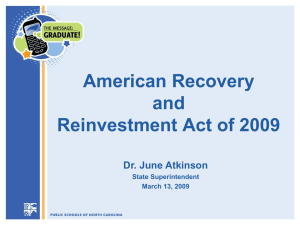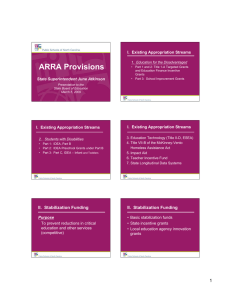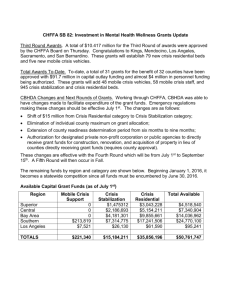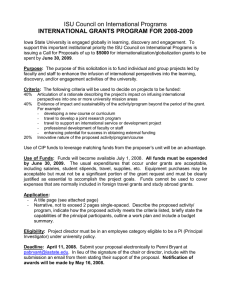Superintendents’ Quarterly Meeting March 13, 2009
advertisement
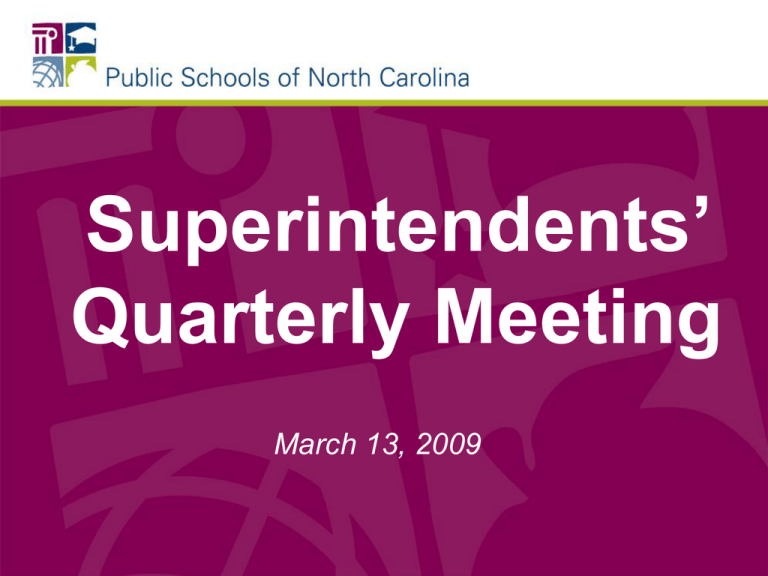
Superintendents’ Quarterly Meeting March 13, 2009 American Recovery and Reinvestment Act of 2009 Dr. June S. Atkinson State Superintendent March 13, 2009 Guiding Principles • Deliver funds quickly • Save and create jobs • Ensure transparency and accountability • Advance reforms North Carolina Direct Allocations • Title I-A • IDEA, Part B $258 m $314 m North Carolina Direct Allocations • • • • • • Title 1 (School Improvement) IDEA, Part C IDEA, Preschool Education Technology School Lunch Equipment Homeless Education $76 m $13 m $12 m $16 m $2.8 m $1.3 m North Carolina Direct Allocations • State Stabilization Fund $1.2 b Progress Toward Four Reforms • Rigorous standards and quality assessments • Data systems • Teacher effectiveness and equitable distribution • Intensive support and effective interventions Existing Appropriation Streams 1. Education for the Disadvantaged • Part 1 and 2: Title 1-A Targeted Grants and Education Finance Incentive Grants • Part 3: School Improvement Grants Title I, Part A Some possible uses • Instructional leaders • Intensive, year-long teacher training for teachers and principals • Early childhood education • High-quality, online courseware Title I, Part A (continued) Some possible uses • Professional development on use of data • Sustainable extended learning before school, after school, during the summer, or over an extended school year Existing Appropriation Streams 2. Students with Disabilities • Part 1: IDEA, Part B • Part 2: IDEA Preschool Grants under Part B • Part 3: Part C, IDEA – Infant and Toddlers IDEA, Part B Some possible uses • • • • Assistive technology devices Professional development Availability of placement options Transition coordinators Title I, Part A & IDEA, Part B • End of March • 50 percent • No new application Title I and IDEA • Remainder of funds available July 1-September 30, 2009 • Additional information required Other Existing Funding Streams • IDEA, Part C • Impact Aid Construction • Education for Homeless 50% 40% 100% Fall 2009 (formula) • Title I School Improvement • Education Technology State Grants State Fiscal Stabilization Funds (SFSF) • Public early learning, K-12, higher education (81.8%) • Education, public safety, and other government services (18.2%) 81.8% Funds • Salaries to avoid lay off of teachers and other employees • Modernization, renovation, repair –early childhood –“green” buildings SFSF Requirements • Assurances • Baseline data • Basic fund use 81.8% Funds Any activity authorized by • • • • ESEA IDEA Carl D. Perkins CTE Act Adult Education and Family Literacy Act SFSF Provisions • Governor • 67 percent available – March 31 • Streamlined state application • Two-week turnaround 1. Basic Stabilization Funds Grant Application Assurances • • • • • • Maintenance of state effort Teacher effectiveness and distribution Data systems Academic assessments Standards School improvement 2. Incentive Grants • Governor must submit application to the Secretary of Education; some items are -State’s status in each area addressed in the assurances -Achievement and graduation rates -How grant will be used to improve student academic achievement Competitive Grant Process (Fall 2009) • Teacher Incentive Fund • Teacher Quality Enhancement • Statewide Data Systems $5 Billion Race to the Top Innovation Race to the Top (Fall 2009, Spring 2010) Invest in What Works and Innovation $650 Million • Competitive • Districts and non-profit groups • Strong track record of results 3. Local Innovation Fund • Direct grants to LEAs or partnerships 3. Local Innovation Fund Uses • Significantly closing achievement gaps or increasing student achievement • Exceeding the state’s measurable objectives for performance on state assessments • Significant improvements in other areas such as graduation rate • Demonstrated established partnerships Accountability Accountability and Transparency • Detailed description of uses of funds • Quarterly reports—financial and program outcomes/results • Estimated number of jobs created and retained • Compliance of subcontracts and subgrants Note: All reports on www.recovery.gov Accountability • Jobs saved or created • Use of funds • State’s progress in areas covered by application assurances • Disrupting Class (Clay Christenson, 2007) • Leading the Revolution (Gary Hamels, 2000) • It’s Being Done (Karin Chenoweth, 2007) • Whatever It Takes (Paul Tough, 2008) From… To… School-Wide system of support for student achievement should look like this: Intensive Intervention 5% Strategic Interventions 15% Core Curriculum 80% •Failure •Flight •Fight Questions??? American Recovery and Reinvestment Act of 2009 Dr. June S. Atkinson State Superintendent March 13, 2009 Superintendents’ Quarterly Meeting March 13, 2009
